
Red Pepper Paste
dairy free, Gluten-free, Sugar Free, Vegan
A classic, Turkish, Armenian and Middle Eastern concentrated red pepper paste, that is mainly used as a flavoring . Use it on grilled potatoes, spoon it on grilled kebabs, cutlets and chicken, or even add it as a flavor supplement to soups, stews and pasta sauce! Apply it pretty much anywhere, but it is especially stellar smothered on Lebanese bread and grilled to make a delicious accompaniment to grilled sheesh tawook, chicken shawarma or kafta kababs. A few tablespoons can dramatically enhance the taste of tons of dishes, as it adds such a smack punch and can take a good recipe you’ve made and turn it into something even better. It is ready available at Middle Eastern markets; see how interesting making a batch at home. I used aruba red pepper, but red bell pepper can be used; if you are anything like me and prefer it spicier, mix in some hot peppers, they add a splash of heat that brings us a lot of joy when we eat!

Red Pepper Paste
The paste can be made in the oven, on stovetop or a combination of both together. It is easy, and the process is all about reducing the amount of liquid in the peppers to produce a paste. The only tricky part is that you have to watch closely to prevent burning, other than that, it is a straightforward technique!

- Red peppers: I used aruba red pepper, but red bell pepper or any type of red pepper can be used, if you prefer it spicier, mix in some hot peppers.
- Type of salt used: Salt is an essential ingredient for flavor, and it is advisable to use pickling salt. By far, it is the best for fermenting food since it is free of additives and anti-caking agents, which will help prevent short-term spoilage. If you can’t find pickling salt, kosher salt is a great alternative.
- Vinegar: vinegar is used in the red pepper paste to increase its longivity. Use white vinegar or even apple cider vinger would do good.
- Olive oil: After jarring the paste, olive oil is added on top, it helps preserve the sauce’s fresh flavors.
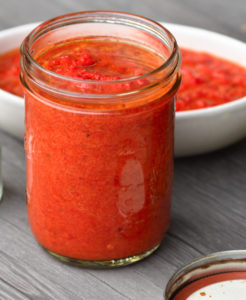
I have used the stovetop method!
Select fresh and firm red peppers free of blemishes or damage. Wash the peppers thoroughly and drain, cut each in half lengthwise and remove the seeds. Transfer to a pot large enough to accomodate the red peppers, add water half way up the side of the pot. Cover the lid and simmer for 60 minutes, or long enough to soften the pulps. Drain in a colander to remove the excess liquid, and set aside. Transfer the peppers, in batches,to a food mill, I prefer to use a hand mill! It may not be the first kitchen untensil that comes to mind when racking your brain listing and buying your kitchen gadgets, but it is essential for lots of foods, including my “Lebanese Brown Lentil Soup“. In making the red pepper paste, a food mill has two main functions, it purees the peppers, ending up with a brighter red unctuous sauce, simply because a food mill doesn’t add air to the sauce, unlike a food processor or blender! Second, it gets the skin of the peppers out as it eliminates the need to strain; in other words a hand mill will mash and sieve your red pepper paste. Secure the food mill above a bowl, turn the crank and the blade will neatly puree the peppers, making sure to scrape any remaining off the bottom. Skin and any escaped seeds will be removed, leaving you with the desired red bright blood pepper sauce. At this stage the red pepper puree is not thick enough and it does weep some water since it hasn’t reached the paste stage, so we have to cook it a second time, over low heat, until the desired consistency is reached.
Return back the pepper sauce to pot and cook, uncovered, over low heat, stirring frequently. It is important to hydrate the sauce over low heat, if it is too high the paste will brown rather than sweat. Keep on low, watch closely to prevent burning, stir until the red sauce thickens to a loose paste. Remove from heat and season with pickling salt while the paste is still warm. Taste a bite and add more salt if needed, salt should be pretty obvious since it acts as a preservative. Stir in white vinegar and set aside.
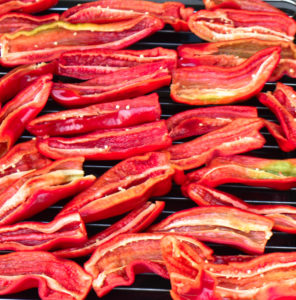
Alternatively, you can dehydrate the red peppers in the oven at a very low temperature; but beware, you don’t want to char your peppers; the key to drying in the oven is the low temperature.

Storage: Completely cool down before jarring. Use some right away and portion the rest in small glass jars, top each jar with a generous layer of olive oil, keep it for 1 month in the refrigerator or stock in your freezer, they can go a long way! Alternatively, portion the paste into ice-cubes trays, anytime you need, pull out a cube or more as desired.
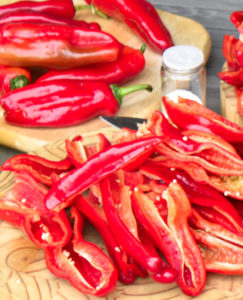


Ingredients
- 1 kg/ 2lb 4oz fresh red pepper, and a few more hot peppers if you like a splash of heat
- 1/3 cup white vinegar
- 11/2 tablespoons pickling salt or kosher salt
- olive oil to drizzle on top of the jars before securing
Directions:
- Select fresh and firm red peppers free of blemishes or damage. Prepare your red peppers and wash them thoroughly and drain, cut each red pepper in half lengthwise and remove the seeds.
- Transfer to a pot large enough to accomodate the red peppers, add water half way up the side of the pot. Cover the lid and simmer for 60 minutes, until the peppers have softened. Drain in a colander to remove the excess liquid, and set aside.
- Transfer the peppers, in batches, to a food mill. Secure the food mill above a bowl, turn the crank and the blade will neatly puree the peppers, making sure to scrape any remaining off the bottom. Seeds and skin will be removed, leaving you with a smooth, bright red blood pepper sauce that is still watery a bit.
- Return back the pepper sauce to pot and cook, uncovered, over low heat, stirring frequently. It is important to hydrate the sauce over low heat, if it is too high the paste will brown rather than sweat. Keep on low, watch closely to prevent burning, stir until the red sauce thickens to a loose paste.
- Remove from heat and season with pickling salt while the paste is still warm. Taste a bite and add more salt if needed, salt should be pretty obvious since it acts as a preservative. Stir in white vinegar and set aside.
- Completely cool down before jarring. Use some right away and portion the rest in small sterilized glass jars, top each jar with a generous layer of olive oil keep it for 1 month in the refrigerator or stock in your freezer, they can go a long way! Alternatively, portion the paste into ice-cubes trays, anytime you need, pull out a cube or more as desired.

- The book is now available, with free shipping for prime members on Amazon, grab a copy!
- Thank you to all the readers who purchased “Hadia, Lebanese Style Recipes”. If you have a minute to spare, please rate and review the book on Amazon. We would like to know what you think! Here is the link to AMAZON

Subscribe to our YouTube channel for the latest weekly updates. To get all notifications, tap the notification bell: https://www.youtube.com/channel/UClinjfG9SVXSHMdjx8yGoWg
Another Red Pepper Based Recipe worth learning: Muhammara/ Red Pepper and Walnut Dip
If you make the "Red Pepper Paste ", leave a comment below, or share your pictures on Facebook! I would love to see your creations!! Hashtag, #Hadia’s lebanese Cuisine
Subscribe to Our Newsletter
Instructions
No Steps Found !
- Course : APPETIZERS, condiment, flavor bomb
- Recipe Type : APPETIZERS, flavor booster, LEBANESE RECIPES, RECIPES FROM AROUND THE WORD
- Ingredient : aruba pepper, red bell pepper
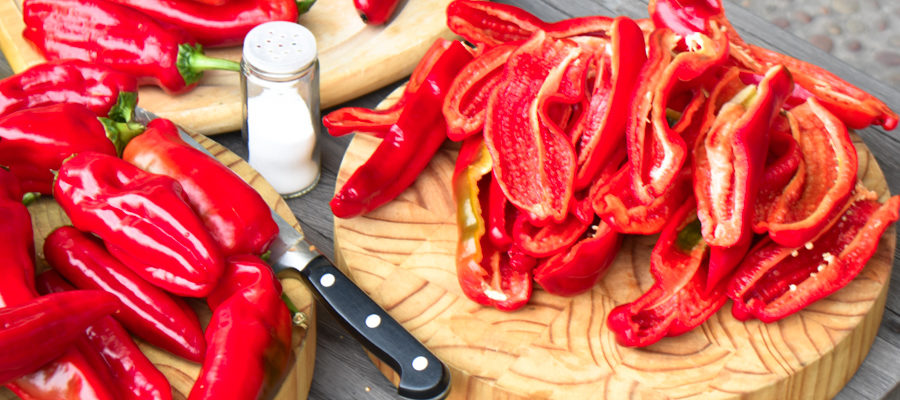
4 Responses to Red Pepper Paste
Leave a Reply to Alice Click here to cancel reply.
About Chef
Hadia Zebib
I am Hadia, the face behind Hadia’s Lebanese Cuisine. I grew up in Beirut Lebanon and I currently reside in Kinshasa, Congo with my husband and my three adorable sons, ...
Read more about this chef..

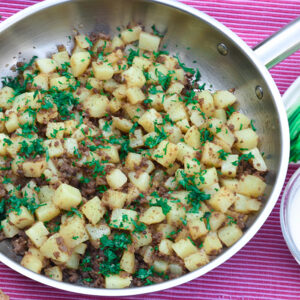
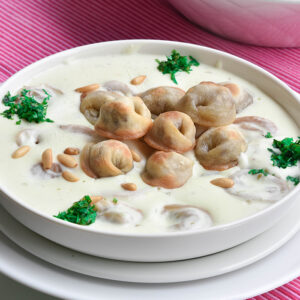
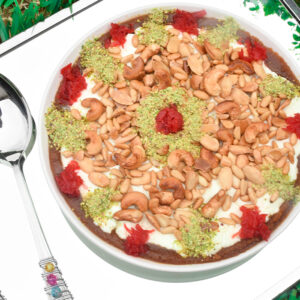


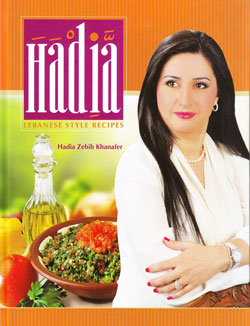
Your book is not available on Amazon anymore
Alice, it will be back in a few days, kkindly check later!
Is this pepper sauce the same as Shatta?